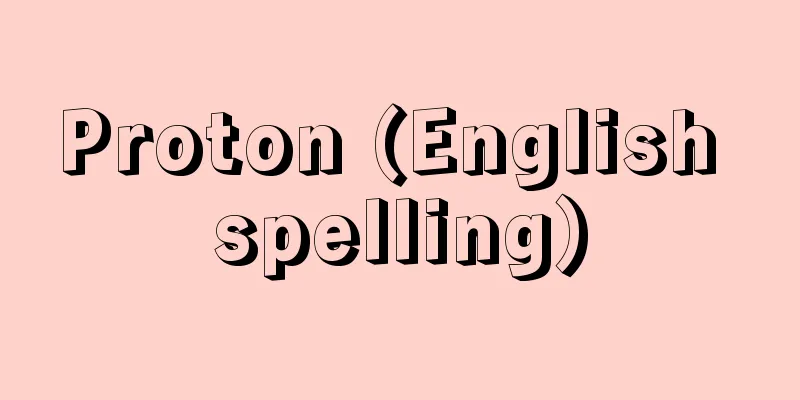Proton (English spelling)

|
A type of elementary particle, also called a proton. It has a positive charge and is equal in size to that of an electron. In current particle theory, it is considered to be made up of two u quarks with a charge of 2/3 and one d quark with a charge of -1/3. A proton has a size and an extent of about 10 -13 centimeters. As it is a component of an atomic nucleus along with neutrons, it is collectively called a nucleon, which is a collective term for protons and neutrons. The type of atomic nucleus is specified by its atomic number and mass number, and its chemical properties are determined by its atomic number. The atomic number is the number of protons, and the mass number is specified by the sum of the number of protons and neutrons. The mass of a proton is 1.6726×10 -24 g, about 1836 times that of an electron. It has a spin of 1/2 and follows Fermi-Dirac statistics, and its magnetic moment is about 2.7928 e ħ/2 m p c ( m p is the proton mass, ħ is 1/2π of the Planck constant h ). Research on cathode rays, which began in the mid-19th century with the development of vacuum technology, led to the establishment of the existence of electrons by British J. J. Thomson's measurement of the specific charge ( e / m e ) (1897). On the other hand, research on anode rays, which were molecular beams (ion beams), showed that their specific charge was very small (about one thousandth) compared to cathode rays, but the values were inconsistent and did not lead to the establishment of the existence of protons. British E. Rutherford analyzed the phenomenon in which alpha particles are often scattered at large angles by gold and platinum foils, and revealed that almost the entire mass of an atom is concentrated in a very narrow region at the center of the atom (1911), proving the atomic model that an atom is composed of a nucleus that carries almost the entire mass of the atom and electrons surrounding it. Thus, the existence of protons was established as the nucleus of the lightest atom, hydrogen. For the matter in the universe to exist stably, protons are required to be stable and not decay into other elementary particles, but even if they decay with a half-life of more than about 10 31 years, this does not contradict the current observational facts. Incidentally, the age of the universe is about 1.3 × 10 10 years. The Grand Unified Theory (GUT), which describes the three interactions of electromagnetic, weak, and strong interactions in a unified manner, predicts that protons will decay with a half-life of about 10 31 to 10 32 years, since it includes interactions that do not conserve the number of nucleons. According to this theory, when the current universe was created by a big explosion (the Big Bang), the synergistic effect of the non-conservation of the number of nucleons and the violation of CP invariance (the violation of time-reversal symmetry) occurred, which explains well why the universe is made up of only matter and the symmetry of matter-antimatter is lost. Hopes are high for experimental verification of proton decay. [Toshihide Maskawa] [References] | | | | | | elementary | | neutron | | | | | | | | |Source: Shogakukan Encyclopedia Nipponica About Encyclopedia Nipponica Information | Legend |
|
素粒子の一つで、プロトンともいう。正の電荷をもち、大きさは電子のそれに等しい。現存の素粒子論では、電荷2/3のuクォーク2個と-1/3のdクォーク1個からできていると考えている。陽子は大きさをもち、その広がりは約10-13センチメートルである。中性子とともに原子核の構成要素であるので、陽子と中性子の総称として核子といわれる。原子核の種類は原子番号と質量数で指定され、化学的性質は原子番号で決まる。原子番号は陽子の個数であり、質量数は陽子と中性子の個数の和で指定される。陽子の質量は1.6726×10-24gで、電子の約1836倍である。スピン1/2でフェルミ‐ディラック統計に従い、その磁気モーメントは約2.7928eħ/2mpcである(mpは陽子質量、ħはプランク定数hの2π分の1)。 真空技術の発達に伴って19世紀なかばに始まる陰極線の研究は、イギリスのJ・J・トムソンによる比電荷(e/me)の測定により電子の存在を確立した(1897)。一方、陽極線の研究は、それが分子線(イオンビーム)であったため、比電荷は陰極線に比べ非常に小さいこと(約数千分の1)がわかったが、その値はばらばらで陽子の存在を確立するに至らなかった。イギリスのE・ラザフォードは、金箔(きんぱく)や白金箔でのα(アルファ)粒子の散乱で大きな散乱角のものが多い現象を分析して、原子のほぼ全質量が原子の中心の非常に狭い領域に集中していることを明らかにし(1911)、原子は、原子のほぼ全質量を担う原子核と、それを取り巻く電子からできているとする原子模型を実証した。こうしてもっとも軽い水素原子の原子核として陽子の存在が確立した。 宇宙の物質が安定に存在するために、陽子は他の素粒子に崩壊せず安定であることが要求されるが、約1031年以上の半減期で崩壊していても現存の観測事実と矛盾しない。ちなみに、宇宙の年齢は約1.3×1010年である。電磁相互作用、弱い相互作用、強い相互作用の三つの相互作用を統一的に記述する大統一理論(GUT)では、核子数が保存しない相互作用を含むので、陽子が約1031~1032年の半減期で崩壊することを予言する。 この理論によれば、大爆発(ビッグ・バン)により現存の宇宙が創生される際に、この核子数非保存とCP不変性の破れ(時間反転対称性の破れ)の相乗効果がおこり、その結果、宇宙が物質のみからなり、物質―反物質の対称性が失われていることをよく説明する。陽子崩壊の実験的検証に期待が集まっている。 [益川敏英] [参照項目] | | | | | | | | | | | | | | | | | |出典 小学館 日本大百科全書(ニッポニカ)日本大百科全書(ニッポニカ)について 情報 | 凡例 |
Recommend
totipalmate
…In frogs, waterfowl, otters, and some other mamm...
Rada (English spelling)
In Ukrainian and Polish, it means a meeting, assem...
Huntington Library
A private library in San Marino, a suburb of Los A...
Osashida - Osashida
…It is distributed in Hokkaido, Honshu, Shikoku, ...
Loncocarpus
...It was an effective fishing method because of ...
Ambrose Bierce
American journalist and novelist. Known as an unp...
skittle
…Instead of playing outdoors, a wooden lane is la...
Brontēs (English spelling)
...When Odysseus and his men arrived on the islan...
Casnewydd
…the city is a port city located in the south of ...
fringed peony
...For example, there are the goldenrod (illustra...
Tales from a Chinese Academy of Fine Arts
A collection of supernatural stories written in l...
Cafe Lion - Cafe Lion
…The word “cafe” originally meant “coffee,” but i...
Zachsia zenkewitschi (English spelling) Zachsiazenkewitschi
...The tail plug is long and shaped like a wheat ...
Tales of economic prosperity - Keikokubidan
A full-length novel by Yano Ryukei. Its correct t...
Confederate vine
...An evergreen, climbing, semi-shrub of the Poly...









